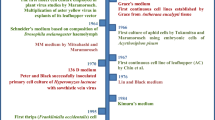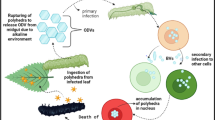Abstract
Cultured cells offer a wide range of usages for studies of insect physiology, toxicology and pathology. Embryonic eggs from western flower thrips (WFT) were used to develop primary cell cultures for studies of the replication of tomato spotted wilt virus (tospoviruses) in their thrips vectors. Development of a thrips cell culture allows examination of virus-vector interactions at the cellular level. Several insect cell culture media were evaluated for suitability to establish primary thrips cell cultures. The best combination of media allowed cells to survive for 100 d. Two types of cells were readily observed. Within 1-2 d after initiating a culture, fibroblast-like cells become the dominant cell type, and at ≈20 d, epithelial-like cells were observed. These cells were subsequently subcultured to develop a thrips-cell line.
Access this chapter
Tax calculation will be finalised at checkout
Purchases are for personal use only
Preview
Unable to display preview. Download preview PDF.
Similar content being viewed by others
References Cited
Adam, G. & E. Sander. 1976. Isolation and culture of aphid cells for the assay of insect-transmitted plant viruses. Virology 70: 502–508.
Black, L. M. 1969. Insect tissue cultures as tools in plant virus research. Ann. Rev. Phytopathol. 7: 73–100.
German, T. L., Y. Hu, J. J. Cho & D. E. Ullman. 1991. Detection of tomato spotted wilt virus RNA in plant and thrips using strand-specific probes, pp. 137-43. In H. T. Hsu & R. H. Lawson [eds.], Virus-thrips-plant interaction of tomato spotted wilt virus. Proc. USDA Workshop, USDA Res. Serv., ARS 87.
Hsu, H. T., D. L. Nuss & G. Adam. 1983. Utilization of insect tissue culture in the study of the molecular biology of plant viruses, pp. 189–214. In K. F. Harris [ed]. Current topics in vector research, Vol. 1. Praeger Publishers, New York.
Kuroda, Y. & Y. Shimada. 1989. Electron microscopic studies on in vitro differentiated cells from Drosophila embryos, pp. 77–89. In J. Mitsuhashi [ed.], Invertebrate cell system applications, Vol. 1. CRC Press, Inc, Boca Raton, FL.
Mitsuhashi, J. 1989. Invertebrate cell system applications, Vol. 1. CRC Press, Inc., Boca Raton, FL.
Murai, T. 1982. Simple rearing method of thrips. Plant Protect. Bull. 36: 34–37.
Sakimura, K. 1963. Frankliniella fusca, an additional vector for the tomato spotted wilt virus, with notes on Thrips tabaci, another vector. Phytopathology 53: 412–15.
Sether, D. M. & J. D. DeAngelis. 1992. Tomato spotted wilt virus host list, bibliography. Spec. Rep. 888. OR State Exp. Sta.
Ullman, D. E., J. J. Cho, R.F.L. Mau, W. B., Hunter, D. M. Westcot & D. M. Custer. 1992. Thrips-tomato spotted wilt virus interactions: Morphological, behavioral and cellular components influencing thrips transmission. In K. F. Harris [ed.], Advances in disease vector research, Vol. 9. Springer-Verlag, New York.
Wijkamp, I., J. van Lent, R. Kormelink, R. Goldbach & D. Peters. 1993. Multiplication of tomato spotted wilt virus in its insect vector, Frankliniella occidentalis. J.Gen. Virology 74: 341–349.
Author information
Authors and Affiliations
Editor information
Editors and Affiliations
Rights and permissions
Copyright information
© 1995 Springer Science+Business Media New York
About this chapter
Cite this chapter
Hunter, W.B., Hsu, HT. (1995). Establishing Thrips Cell Cultures to Study Tospoviruses. In: Parker, B.L., Skinner, M., Lewis, T. (eds) Thrips Biology and Management. NATO ASI Series, vol 276. Springer, Boston, MA. https://doi.org/10.1007/978-1-4899-1409-5_22
Download citation
DOI: https://doi.org/10.1007/978-1-4899-1409-5_22
Publisher Name: Springer, Boston, MA
Print ISBN: 978-1-4899-1411-8
Online ISBN: 978-1-4899-1409-5
eBook Packages: Springer Book Archive




